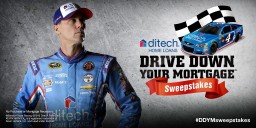
I think we can all agree that cutting through is hard these days. There are more brands than ever vying for our attention across a myriad of platforms and channels. Consumers have become extremely adept at tuning out all these messages, time shifting to avoid TV ads and using ad blockers to avoid their digital brethren. So what’s a marketer to do, especially one wanting to reach a truly mass audience?
This was the conundrum facing Rich Smith when he took the reins as CMO at Ditech Financial in 2014. Without going into all the gory details, Ditech became a household name in the mortgage business in the 90’s, got acquired by GMAC in 1999, was merged and submerged over the next 14 years and then re-emerged as a standalone entity in 2014. Given this circuitous history, it was important to Rich that the brand regain lost ground quickly, capitalizing on any familiarity with the name while adding on a new sense of energy. To do this, Ditech turned to NASCAR, an effort that worked remarkably well as you will see in our interview below.
[Please note that this is only part of our extensive interview after Rich was awarded the Marketing Innovation Award by The CMO Club late last year. Part 2 will be posted shortly.]
Drew: What led you to sponsoring NASCAR?
We signed the deal with Stewart-Haas Racing of NASCAR in September 2014. It really didn’t get big at all until 2015. It’s been a great relationship for expanding our brand awareness in a relatively low cost way. We’ve gotten a lot of bang for our buck out of it. The days of people gathering around TV at 8:00 o’clock at night to watch a certain primetime show are kind of gone with the advent of the DVR and Netflix streaming and time shifting. So, one of the best places to invest brand building advertising dollars are live events, like sports. In many ways we’re a start up, re-launching a brand and we don’t have the really deep big pockets of other larger advertisers. The NFL, NBA and MLB are extremely expensive and it is hard to do both on a national and local level. NASCAR is the fourth largest sport in the United States in terms of reach and as I said earlier, it’s been a really cost effective way for us to build brand awareness.
Drew: Interesting. Tell me more about your NASCAR relationship.
The beauty of NASCAR is it’s a sport that completely gets the sponsorship model. Just watch a race and you’ll see the logos of Fortune 500 companies everywhere. The entire sport gets that sponsors make the sport go around. The fans understand that sponsors make the sport go round. Even though it might be fourth largest in terms of fan-base size, it’s number one in terms of brand loyalty with sponsors, without a doubt. It is also has a very good overlap with our target market and relatively low cost inventory. They race 38 out of 52 weekends a year, so it’s almost year round. And there is a home game in a different city almost every weekend. So, you get national coverage at a relatively low price point. It’s definitely helped us grow brand awareness with a relatively modest budget.
Drew: How do you evaluate the effectiveness? Is it brand tracking that simply shows that pre and post awareness went up as a result of this program?
We track it in a lot of different ways and we’re working on refining and getting even more analytical about how we do this. We do pre and post brand awareness surveying and analysis. We also do direct tracking through our websites during events and the resulting activity of that traffic. We monitor the impact of social media through the sponsorships. We have separate social properties that we use for the sponsorship. We look at engagement rates on various pieces of content. I would say that even though our social following is relatively small, it’s growing rapidly and we’ve achieved much higher engagement rates in social media than most of our competitors do. People attend, interact and engage with our content at a much higher rate than most of our competitors. Some of that content is related to the sponsorship, most of it isn’t but they work well together.
Drew: Interesting. What if your CFO walked in the door and said, “All right, we’re spending X thousands of dollars on NASCAR can you actually show this pays out?”
It is difficult to correlate exactly to new customers. That said, there are lots of quantifiable metrics. For example, we do track all of the exposure we get through the sponsorship. We track every time our logo appears on the screen, how many seconds was it there and how many people saw it. And we know the value of that media. So we can show the cost of the sponsorship relative to the value of the exposure we’ve received.